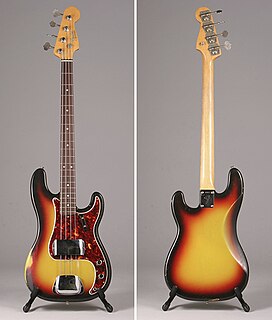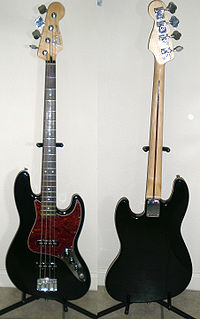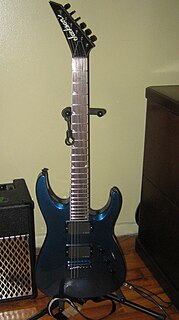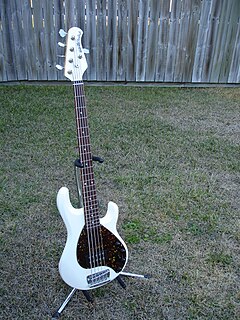Related Research Articles
The Fender Jazzmaster is an electric guitar designed as a more expensive sibling of the Fender Stratocaster. First introduced at the 1958 NAMM Show, it was initially marketed to jazz guitarists, but found favor among surf rock guitarists in the early 1960s. Its appearance is similar to the Jaguar, though it is tonally and physically different in many technical ways, including pickup design, scale length and controls.

Music Man is an American guitar and bass guitar manufacturer. It is a division of the Ernie Ball corporation. The company is most well-known for its electric and bass guitars. Determined to maintain a reputation for quality, the Music Man company largely produces high-end guitars, especially after being acquired by Ernie Ball in 1984.

The Fender Precision Bass is a model of electric bass manufactured by Fender Musical Instruments Corporation. In its standard, post-1957 configuration, the Precision Bass is a solid body, four-stringed instrument equipped with a single split-coil humbucking pickup and a one-piece, 20-fret maple neck with rosewood or maple fingerboard.

The Fender Jazz Bass is the second model of electric bass created by Leo Fender. It is distinct from the Precision Bass in that its tone is brighter and richer in the midrange and treble with less emphasis on the fundamental frequency. The body shape is also different from the Precision Bass, in that the Precision Bass has a symmetrical lower bout on the body, designed after the Telecaster and Stratocaster lines of guitars, while the Jazz Bass has an offset lower bout, mimicking the design aesthetic of the Jaguar and Jazzmaster guitars.

The Bongo is a model of bass guitar manufactured by Music Man, a division of Ernie Ball. It was first introduced at the NAMM Show on March 21, 2003. Ernie Ball president Sterling Ball designed the instrument in conjunction with the Music Man Research and Development department and BMW's Designworks team. It is equipped with an 18-volt 4-band preamp designed by Dudley Gimpel with help from Cliff Hugo and other Music Man artists. It also sports a sleek, carved basswood body with high-gloss polyester finish and a satin-finish painted 34" scale maple neck with rosewood fingerboard featuring 24 high-profile wide frets and crescent moon-shaped position inlays. These basses are generally known for their dual humbucking pickup configuration, as they are the first twin humbucker-equipped models released by Music Man since the introduction of their Sabre and Cutlass bass guitars in the late 1970s.
The Fender Duo-Sonic is an electric guitar launched by Fender Musical Instruments Corporation as a student model guitar, an inexpensive model aimed at amateur musicians. It was referred to as a "3/4 size" Fender guitar.
The Fender Lead Series was produced by the Fender/Rogers/Rhodes Division of CBS Musical Instruments. The series comprised Lead I, Lead II, Lead III and Lead Bass models.

The Squier '51 is an electric guitar made by Squier, a subsidiary of Fender. The '51 is notable for being one of the few original designs made by Squier, which normally manufactures less expensive authorized copies of Fender's popular guitars and bass guitars.

The Jackson Dinky is a Superstrat-style double-cutaway electric guitar built by Jackson Guitars. The "Dinky" is named for its slightly smaller than normal (7/8) body size. Usually fitted with a two humbucker pickup configuration, some models also include single-coil pickups and/or just one bridge humbucker. The fretboard can be made out of ebony, rosewood and more recently maple, or rock maple, with 24 jumbo frets and is always built with a bolt-on neck. Most of the guitars have a Floyd Rose original or licensed tremolo, and a locking nut to help maintain stable tuning. Some Dinkys have hardtail, or String-Thru bridges. The Jackson Dinky is usually preferred by players of hard rock and heavy metal.

The Fender Jaguar Bass is an electric bass guitar manufactured in Japan and China by the Fender Musical Instruments Corporation.

The Gibson L9-S Ripper is a model of electric bass guitar made by Gibson Guitar Corporation.

Introduced in 1987, the StingRay 5 (SR5) was the first all-new Music Man bass designed and built in San Luis Obispo by the Ernie Ball team. The five-string's styling is based on the classic look of the Silhouette guitar. Advanced active electronics combine the best of the four-string StingRay along with innovations from Music Man designers, such as an Alnico humbucking pickup and three-way pickup selector for series, single and parallel combinations. The tuners are placed in a 4+1 configuration and the six-bolt on maple neck has a rosewood or maple fingerboard with 22 high-profile wide frets.

The Gibson L6-S is a solid body electric guitar. It was the descendant of the L5S jazz solid-body electric guitar. It was the same shape, very much like a wide Gibson Les Paul, but with a 24-fret two-octave neck, the first Gibson guitar to have this.
The Gibson Les Paul bass is a bass guitar first manufactured by Gibson in 1969, just after the relaunch of the Les Paul guitar in 1968.
The Fender Bullet was an electric guitar originally designed by John Page and manufactured and marketed by the Fender Musical Instruments Corporation. It was first introduced as a line of "student" guitars to replace the outgoing Mustang and Musicmaster models.

The Ibanez S Series is a guitar series produced by Hoshino Gakki. Introduced in the late 1980s, the S Series is notable for being a streamlined mahogany-bodied guitar with a maple neck that plays comfortably while retaining the resonance of mahogany. Like the RG series, it also has prestige models, as well as derivatives, namely the SZ, SV, and SA series.
The Fender American Deluxe Series was a line of electric guitars and basses introduced by Fender in 1995 and discontinued in 2016. It was upgraded in 2004 and 2010 before being replaced by the American Elite series in 2016.

The Jazz Bass V is the five string (extended-range) version of the Fender Jazz Bass. It comes in several different versions, with active or passive pickups.
The Yamaha Corporation is a multinational corporation and conglomerate based in Japan with a wide range of products and services, predominantly musical instruments, motorcycles, power sports equipment and electronics.
The Fender Telecaster, colloquially known as the Tele, is the world's first mass-produced, commercially successful solid-body electric guitar. Its simple yet effective design and revolutionary sound broke ground and set trends in electric guitar manufacturing and popular music. Introduced for national distribution as the Broadcaster in the autumn of 1950 as a two-pickup version of its sister model, the single-pickup Esquire, the pair were the first guitars of their kind manufactured on a substantial scale. A trademark conflict with a rival manufacturer's led to the guitar being renamed in 1951. Initially, the Broadcaster name was simply cut off of the labels placed on the guitars and later in 1951, the final name of Telecaster was applied to the guitar to take advantage of the advent of television. The Telecaster quickly became a popular model, and has remained in continuous production since its first incarnation.
References
- ↑ http://www.musicmanbass.global/serials-sterling
- ↑ http://static.music-man.com.s3-us-west-2.amazonaws.com/website/files/schematics/2016-01-01/CFD+Sterling+4+H+Bass+20160101.pdf
- ↑ https://www.music-man.com/instruments/basses/sterling
- ↑ http://static.music-man.com.s3-us-west-2.amazonaws.com/website/files/schematics/2016-01-01/CFD+Sterling+4+HS+Bass+20160101.pdf
- ↑ http://static.music-man.com.s3-us-west-2.amazonaws.com/website/files/schematics/2016-01-01/CFD+Sterling+4+HH+Bass+20160101.pdf